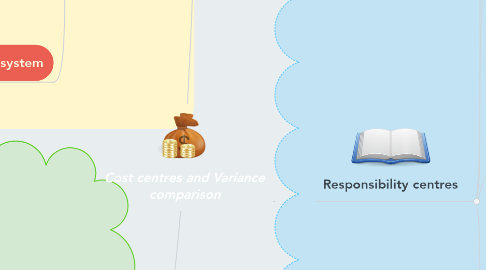
1. Information comparison
1.1. Previous period
1.1.1. year-on-year final figures comparison
1.1.2. month-by-month or quarter-by quarter.
1.1.3. season – by - season
1.2. Forecasts
1.2.1. Most common type: Cash flow forecast
1.2.2. Managers need to compare forecast vs actual results
1.2.3. Can forecast even non-financial information
1.3. Budgets
1.3.1. Budget: A financial plan detailing a company’s objectives and action plans to achieve these objectives in the future.
1.3.2. Compare between budget and actual results to see whether budget holders can achieve the target set to them
1.4. Flexed budget
1.4.1. Budget recognising different cost behaviour patterns and is designed to change as volume of activity changes
1.4.2. Using budgeted/forecasted costs and data, but actual output.
2. Variances
2.1. _Variance reports help budget holders to perform their function of control. _Especially useful if they separate controllable from uncontrollable variances _Variances are: + Favourable if the business has more money as a result + Adverse if the business has less money as a result
2.2. Variances calculations
2.2.1. Sales revenue variance: Total = volume variances + price variances
2.2.2. Cost variance Total direct cost variance = Volume variance (ZERO in flexed budget) + Purchase price variance+ Efficiency of usage variance
2.3. Controllable and Uncontrollable variances
2.3.1. Controllable variances: Can be rectified by managers
2.3.2. Uncontrollable/Non-controllable variances: Are due to external factors beyond the managers’ control.
2.3.3. Variances can also be interdependent: _ A factor can affect more than one variance _ The variances affected can be of opposite directions
2.4. Feedback and Feedforward control system
2.4.1. Feedback control system: Significant variances reported to managers: _Correct the controllable variances _Adjust according to uncontrollable ones.
2.4.2. Feedforward control system: Reporting variances foreseen in the future
3. Responsibility centres
3.1. Function or department of an organisation that is: Headed by a manager Has direct responsibility for its performance
3.2. Responsibility centre => Cost centre: Collects information on costs.
3.2.1. Cost information needed: Total actual costs, total budgeted costs, total cost variances, ratios.
3.2.2. Cost centre measurements
3.2.2.1. Productivity
3.2.2.2. Cost per unit = Total cost / number of units produced
3.2.2.3. Cost per standard hour
3.2.2.4. Actual versus Budgeted performance
3.2.2.5. Ratios
3.3. Cost Centre => Profit centre: Collects information on costs, revenues and profits
3.3.1. a profit for the centre may be calculated
3.3.2. The profit centre manager has some influence over both revenues and costs
3.3.3. Profit centre measurements
3.3.3.1. Profit margin = (Net profit / Sales) x 100% (Also called profit to sale ratio)
3.3.3.2. Gross profit margin=(Gross profit/Sales) x 100%
3.3.3.3. Cost / Sales ratios: Measuring how many % each type of cost takes from sales
3.4. Profit Centre => Investment centre: Collects information on costs, revenues and profits in relation to the value of Non current assets and Working capital.
3.4.1. An investment centre may consist of a group of profit centres!
3.4.2. This kind of information is required by senior management, in order to determine whether their investment into non current assets or capitals are worthwhile or whether they need to change their decisions.
3.4.3. We need to calculate profit for these centres, then calculate their return rate over capitals.
3.4.4. Responsibility centres in which we need to also calculate return on capital employed (Or return on Assets of the centres).
3.4.5. Investment centre measurements
3.4.5.1. Return on capital employed (ROCE) = (Profit/Capital employed) x 100%
3.4.5.2. Residual income: A centre’s profit after deducting a notional interest cost. _The cost = Rate of return required x Capital employed
